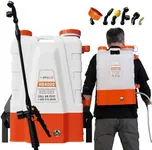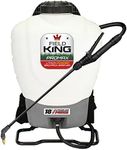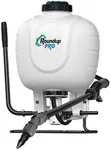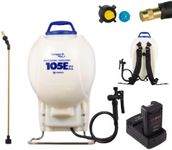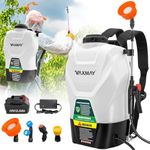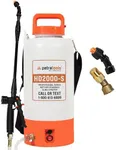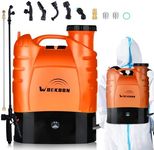Buying Guide for the Best Electric Backpack Sprayers
Choosing the right electric backpack sprayer can make tasks like gardening, pest control, or disinfecting much easier and more efficient. The key is to match the sprayer’s features to your specific needs, whether you’re treating a small garden or a large property. Understanding the main specifications will help you select a sprayer that is comfortable, effective, and reliable for your intended use.Tank CapacityTank capacity refers to how much liquid the sprayer can hold at one time. This is important because it determines how long you can spray before needing to refill. Smaller tanks (around 2-3 gallons) are lighter and easier to carry, making them suitable for small gardens or short tasks. Medium tanks (4-5 gallons) offer a balance between capacity and weight, ideal for most home users. Larger tanks (6 gallons or more) are best for bigger properties or commercial use, but they can be heavy when full. Choose a tank size that matches the area you plan to cover and your ability to carry the weight comfortably.
Battery LifeBattery life indicates how long the sprayer can operate on a single charge. This is crucial because a short battery life may interrupt your work. Shorter battery life (1-2 hours) is fine for quick jobs or small areas, while longer battery life (3-4 hours or more) is better for larger tasks or professional use. Consider how long your typical spraying session lasts and pick a sprayer with a battery that can handle your workload without frequent recharging.
Pump TypeThe pump type determines how the sprayer pressurizes the liquid. Most electric backpack sprayers use either diaphragm or piston pumps. Diaphragm pumps are more durable and can handle thicker or gritty solutions, making them good for a variety of chemicals. Piston pumps usually provide higher pressure and finer sprays, which is useful for precise applications. Think about the types of liquids you’ll be spraying and whether you need durability or higher pressure to guide your choice.
Spray PressureSpray pressure, measured in PSI (pounds per square inch), affects how far and how finely the liquid is sprayed. Lower pressure (up to 40 PSI) is suitable for gentle watering or applying herbicides. Medium pressure (40-70 PSI) works well for most garden and pest control tasks. Higher pressure (above 70 PSI) is needed for reaching tall plants or covering large areas quickly. Match the pressure to your application needs—delicate plants need less pressure, while larger or taller areas may require more.
Nozzle OptionsNozzle options refer to the different spray patterns and flow rates you can achieve. Adjustable or interchangeable nozzles allow you to switch between a fine mist, a steady stream, or a wide spray. This flexibility is important if you plan to use the sprayer for different tasks, such as fertilizing, pest control, or cleaning. If you have varied needs, look for a sprayer with multiple nozzle options; if your use is consistent, a single suitable nozzle may be enough.
Comfort and ErgonomicsComfort and ergonomics relate to how easy and comfortable the sprayer is to wear and use. Features like padded shoulder straps, adjustable harnesses, and lightweight designs reduce fatigue during long use. If you expect to use the sprayer for extended periods or have back or shoulder concerns, prioritize models with good ergonomic features to make your work more comfortable and less tiring.
Ease of Cleaning and MaintenanceEase of cleaning and maintenance is about how simple it is to rinse out the tank, clean the nozzles, and keep the sprayer in good working order. Sprayers with wide tank openings, removable filters, and accessible parts are easier to clean and maintain, which helps prevent clogs and extends the life of the equipment. If you plan to use different chemicals or want to keep your sprayer in top shape, look for features that make cleaning straightforward.



